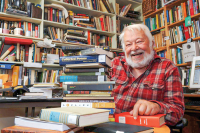Haywood art studio tour
The Haywood County Arts Council’s annual “Haywood County Studio Tour” will be held from 10 a.m. to 4 p.m. Saturday, Sept. 23, and from noon to 4 p.m. Sunday, Sept. 24.
In search of natural beauty: Beloved Designs Woodworking
Woodworking newcomers Matt and Jessa Brantley have already made numerous statements with their eye-catching pieces.
Hope readers enjoyed ‘Smoky Mountain Made’
To the Editor:
Bill Douglas: Passing down a bit of history
Heritage crafter Bill Douglas is continually gathering knowledge about the processes he uses to produce his work and takes great pride in creating historically rich brooms and canework that have traditions dating back hundreds of years.
Cherokee exhibit focuses on mask makers, legacy
Showcased at the Chief Joyce Dugan Cultural Arts Center in Cherokee, a recent exhibition, “Behind the Mask: Cherokee Mask Makers and their Legacy,” aimed to reinforce the significance of Cherokee masks — their history and use, as well as their meaning and significance.
Making a mark: Potter bridges nature, art, memories
While studying English at the University of Mary Washington, Christina Bendo decided to, by chance, take an elective one semester — pottery.
Peeling back the layers: Couple shares Cherokee history, culture
With over 50 years of experience in each of their disciplines, award-winning artisan couple Butch and Louise Goings continuously garner attention with their expertise in Cherokee basket making and wood carving.
All in the family: Riverwood Pottery
Artist family Brant, Karen and Zan Barnes make pottery a philosophical journey that encompasses every portion of their lives.
New book details the history of the John C. Campbell Folk School
In Craft & Community, regional author Anna Fariello presents the early history of Western North Carolina’s John C. Campbell Folk School.
Founded in 1925, the school was a dream of John and Olive Dame Campbell, a working couple who toured the Southern Appalachians in an effort to chronicle its people and their culture.
WCU’s Mountain Heritage Day returns
Western Carolina University’s Mountain Heritage Day, a free family oriented festival that celebrates Southern Appalachian culture through concerts, living-history demonstrations, competitions and awards programs, will be held from 10 a.m. to 5 p.m. Saturday, Sept. 30, on the WCU campus in Cullowhee.
Named one of the top 20 festivals in the Southeast by the Southeast Tourism Society, this year’s event will include additional musical acts, vendors and an expectation of more visitors, organizers said.









